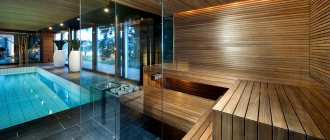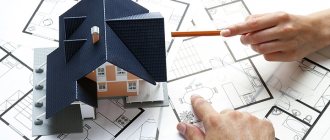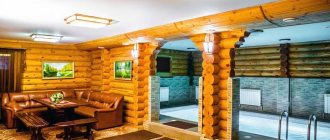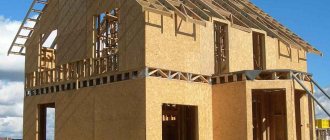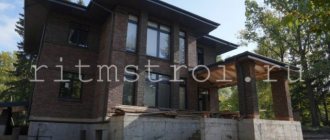Many owners of their own country homes are seriously thinking about building a bathhouse in the basement of their house. More affluent and demanding customers do not stop there, and in addition to the sauna, they also want to equip a swimming pool nearby.
All this can be realized, but it is necessary to prepare for serious expenses associated with the construction and laying of the necessary communications. If you are planning to build a sauna with a swimming pool on the ground floor, we advise you to familiarize yourself with the experience of experts in this matter.
Pool in the basement: construction secrets from the guru
Having your own swimming pool is the “blue dream” of most people, even those who do not have their own home or land.
What can we say about those who own the treasured acres! The dream can become a reality, but this requires more than just a place for a pool and funds for its construction. First of all, you need to have the appropriate knowledge - otherwise, you will get nothing but problems.
We will present a lot of useful information regarding basements and swimming pools, and talk about the technological intricacies of their arrangement.
Bibliography
It is recommended to read the following publications:
- Swimming pool design. Reference manual for SNiP.
- Swimming pools. Set of rules for design and construction. - M.: Soviet sport, 2005.
- Swimming pools. Water supply and sanitation. Kedrov V.S., Kedrov Yu.V., Chukhin V.A. 2002.
Most literary publications consider the construction of sports pools, but they contain the most complete and useful information. During design work, you can use the information obtained, but make some changes taking into account the existing features and operating conditions.
To build a basement with a swimming pool
Many readers are interested in: “Is it possible to install a swimming pool in the basement of an existing house?” Let’s say right away that this idea is not the best, and after reading our article, you will understand why. Those who build with their own hands are not always able to properly insulate even the cellar - and then there’s the pool!
This is a rather complex structure that requires a technically competent approach not only to its construction itself, but to the installation of engineering equipment. It needs to be built together with the house, and preferably according to the project - then you can be sure that everything will function as it should.
Swimming pool in the house: pros and cons
The room in which the pool is supposed to be installed must have a height of at least 2.8 meters. This is necessary, first of all, in order to install a suspended ceiling in which the ventilation ducts, air conditioning system, and lighting fixtures will be hidden.
Note! At such a depth, a plastic pool is out of the question - you only need to build a concrete monolithic version! First of all, you need to be sure that the groundwater lies below the calculated level by at least half a meter. Only then does it make sense to build a swimming pool in the basement.
In any case, the room in which the pool is located automatically goes into the category of rooms with high humidity. If you are going to place it in a house, you should pay special attention to insulating the floor between the basement and first floors. Otherwise, condensation will form on it, and the fumes will enter the living area.
We are drawing up a project
After we have analyzed all the nuances, we can proceed to creating the project and drawings.
The size of the room for the steam room depends on the availability of free space and the tastes of the owners, but it is recommended to focus on 12-14 square meters. m. Such an area will allow 3-4 people to comfortably stay in it at the same time, equip a shower stall and a dressing room.
The optimal ceiling height is 1.8-2 m. If made higher, it will complicate rapid heating, and if it is lower, it will create difficulties for tall people.
The average recommended steam room size is 3 square meters. m. Again, if you build more, it will require a more powerful and expensive heating system. Such rooms are characterized by the arrangement of several tiers of shelves, up to 50 cm wide, with the same distance from the floor.
We invite you to read: Two-story bathhouse: what are its advantages and how to equip the upper floor
Two of the four walls of the steam room must be adjacent to the walls of the main building. It is important to have the ability to organize ventilation, water supply and drainage, and power supply.
What to consider when building a swimming pool
The technology for constructing a swimming pool bowl has much in common with the construction of the basement itself. In both cases, it is necessary to ensure complete tightness of the structure - although, of course, the strength of the walls of the pool should be disproportionately higher, since they are constantly under water pressure.
Important! Some home-grown specialists do this: first they fill a solid bowl, and then make grooves in the right places where they insert the embedded parts. This is the wrong approach; chipping concrete violates the integrity of the bowl, and it should not be subjected to any mechanical stress. Microcracks will appear, and water will go into the ground - or vice versa, groundwater will flow into the pool.
So, it’s better to entrust the construction of the pool to a specialized company, and once the bowl is filled, you can take care of its lining yourself and carry out further work on arranging the basement.
Work order and other nuances
We have already said that it all starts with formwork. After pouring, it is almost impossible to obtain a bowl with a perfectly flat surface - especially in those areas that have curves, differences in bottom height, steps and protrusions. First of all, the quality of the surface is ensured by the formwork.
Only before starting finishing, the quality of waterproofing is tested. The bowl is filled with water and observed for three days to see if there is any leakage. If everything is fine, the water is drained, the inner surface of the pool is dried, and only then the lining begins.
Arrangement of the pool premises
Let's start with the fact that during the construction of swimming pools and rooms adjacent to them, the use of materials with a cavernous structure that can strongly absorb moisture is not allowed. These include blocks (stones) made of cellular and lightweight concrete, all types of sand-lime brick. Only ceramic bricks can be used, but in no case hollow bricks.
Attention! If the walls are sheathed with moisture-resistant plasterboard (GKLV), then it also needs to be impregnated, and on both sides. Under the sheathing, the base surface should also be protected with a rolled waterproofing membrane and insulation based on extruded polystyrene foam or polyethylene foam should be installed.
In a room such as a basement with a swimming pool, the best options are an aluminum slatted or cassette ceiling, or a stretched PVC sheet. If, before installing them, the floors are prepared as we recommended, there will be no danger of moisture entering the house or the formation of mold on the underlying foundations.
Victor Martovich
Source
Differences between a Russian bath and a sauna
In order to correctly draw up a high-quality project, take into account all the nuances, and equip a good, properly functioning room, you need to decide in advance what you want to have in your basement: a regular bathhouse or a sauna? Let's look at their differences:
- The operation of a sauna is characterized by dry steam obtained from heated elements. In a Russian bath, on the contrary, wet steam is used. The air humidity in a sauna does not exceed 7%, while in a bathhouse it can reach 60-70%;
- The sauna does not involve supplying water to the room - to get steam, it is enough to prepare a small amount of herbal infusions - to wet the stones or a bucket of liquid;
- The temperature of the sauna can reach 120°C, and the temperature of the bath not higher than 70°C;
- It is not difficult to build a sauna; it can be done in almost any room, provided that heat preservation and heat transfer are ensured. For a bathhouse, experts recommend building a separate building, with an individual water supply and drainage system.
Swimming pool in the basement - construction technology
What owner of a country house can do without a bathhouse and a nearby pond. But a pond on the territory of a personal plot is a seasonal pleasure, but a swimming pool in the basement with a bathhouse and a sports room is quite popular and the optimal solution.
In this technical review, we will introduce you to how you can build and equip a basement with a swimming pool and sauna with your own hands. How to create ideal conditions for relaxation in your own home with minimal labor and personal time.
Ventilation, hydro- and sound insulation
Internal ventilation is always based on the action of physical laws - hot air rises and tends to exit through the ventilation hole, while cold air enters through the lower hole and fills the room. Therefore, the most optimal option is when the supply vent is located under the stove, and the exhaust vent is at the level of the second shelves. If additional heating of shower rooms is expected, as well as the presence of a swimming pool, then the ventilation system will be more complex.
To prevent the sauna from becoming a source of unwanted noise and to maintain a presentable appearance for a long time, it is better not to skimp on the quality of building materials for heat, hydro and sound insulation. If funds allow, it is better to take foil materials and carefully seal the joints with foil-based tape. It is important that the insulating materials do not touch the inner lining; to avoid this, transverse and longitudinal slats are used.
Introduction
The best solution for equipping a bathhouse and a pond in the basement would be to plan such structures at the stage of developing a country house project. Since the construction of such facilities requires the presence of serious engineering communications - power supply, ventilation, sewerage.
white small insects in the apartment who are they
And if to install a bathhouse, in a modern configuration, you can get by with a powerful electrical cable and equipping a place for a shower stall (drain), then a swimming pool in the basement of a private house is a serious hydraulic structure that requires sufficient knowledge in this area, and most importantly - skill use this knowledge correctly in practice.
Construction of a bathhouse in a country house is the topic of the next article, and in this one, as you already understood from the title, the construction of a swimming pool in the basement will be discussed in detail. But since the construction of a steam room was mentioned above, I would like to offer developers one of the most profitable options - prefabricated panel structures (see photo).
Prefabricated bath model
The presented room (see photo) is equipped with an electric heater and automatic equipment for turning on and regulating the heating temperature. In addition to this design, you can install a shower cabin, equip it with a special pump (sololift) for forced drainage of waste water to the level of the central sewer system, and the bathhouse is ready.
Generalization on the topic
In addition to the aspects mentioned in the article when equipping a swimming pool in a private home, it is necessary to take care of disinfectant, filter systems, filtration and heating devices, stairs and other devices and interior elements to create comfortable and safe conditions.
Involving specialists and professional teams in the design and construction of an artificial reservoir will help reduce the time of construction and arrangement of the pool, as well as obtain the desired result.
Ratings 0
Types of structures
How to make a basement with a swimming pool? The answer to this question can only be obtained after a detailed study of the structures of the structures themselves, as well as what areas will be needed to accommodate additional equipment and communications.
Placing a swimming pool in the basement requires the availability of the necessary free space and the technical ability to equip this place in accordance with the requirements provided for the convenient and safe operation of this type of structure.
So, how to make a pool in the basement?
There are three main types of structures for equipping an artificial pond in the basement of your own home, these are:
Inflatable models
The easiest option to make a pool with your own hands in the basement is to purchase an inflatable structure. The body is made of polyvinyl chloride film.
Consists of the following parts:
Using a pump, air is pumped into the tank body. Under pressure, the tank straightens, becomes rigid and takes the required shape.
The choice of such models is huge, for every taste, from sizes to additional functions such as hydromassage, slides, etc.
For example, inflatable tank Bestway 57265:
The bowl is made of three-layer polyvinyl chloride, reinforced with mesh around the entire perimeter. Able to withstand moderate mechanical loads.
Reinforcement with PET mesh scheme
The small size and excellent characteristics of the product make it possible to install such pools in the basement of a country house, even with limited space.
Advantages of this type of structure:
Attention! If the pool will be used by small children, do not forget to complete the purchase with inflatable vests and armbands.
The following models already belong to the category of complex structures that require additional knowledge from the developer or the intervention of professionals. Let's start in order - from less complex systems to serious capital structures.
Prefabricated frame structures
Such systems, at first glance, can only be used outside on a personal plot. However, with some skill and sufficient basement space, you can place such a pool in the basement of your house.
If the ceiling height of the room is below 3.0 m, you will have to spend a lot of effort to manually dig the pit bowl. Concrete the bottom and walls.
Move the water filtration installation outside the premises (noise from equipment operation, reagents - chlorine, coagulants, etc.). Such events are appropriate only if you already have a finished basement and a great desire to acquire a full-fledged all-season reservoir located inside the building.
Although if the height of the room is 3.0–3.5 m, then the frame can be assembled on the existing floor. Just in case, let's consider how and in what sequence the installation of swimming pools on the ground floors should take place using prefabricated panel tanks.
Construction stores sell ready-made sets of equipment, and if you are not too limited in funds and room size, then use them. Instructions and recommendations for assembling such structures are necessarily included in the product delivery list.
A homemade prefabricated pool for the basement on a wooden frame can be made from timber and awning fabric.
To assemble the frame, a 100x50 mm pine beam and a 2.5 cm thick edged board are well suited. All lumber must be treated with an antiseptic.
How to install a tank yourself:
The next two sections are devoted to the consideration of monolithic structures that differ only in the way the tank bowls are arranged.
Monolithic structures
Before constructing a basement with a swimming pool, you must carefully read the technical literature regulating the choice of materials and equipment. Complete a construction project, consult with experts, and only then plan and carry out the work.
The tank is made of monolithic reinforced concrete
The choice of materials for equipping tank bowls is in a very wide range, these are:
Monolithic concrete is most in demand. Its durability, heat resistance and good resistance to various aggressive environments make concrete structures a priority in the construction of such structures. But it all depends on the construction conditions and customer preferences.
Design
At the initial design stage, it is necessary to determine the architectural features of the structure:
Then a static calculation is carried out to study the values of external loads in order to determine the optimal safety factor of the structure.
Static calculation includes the following operations:
After this, a process flow diagram is drawn up, which includes the sequence of water treatment for the pool:
Requirements
Necessary conditions for design and construction work:
Upon completion of the design work and passing the project examination, construction can begin.
Construction
The construction of a swimming pool in the basement is carried out in the following sequence:
The technology described above for constructing the bottom of the tank is mandatory for all types of pools (see video in this article).
Next, we decide on the design of the walls of the bowl. Either it will be made of monolithic concrete with subsequent finishing, or the role of the bowl will be performed by ready-made containers made of stainless metal or polypropylene.
Monolithic system
In the case of monolithic concrete:
If the bathroom is equipped from ready-made containers, for example, plastic, then the work order is as follows:
Placing a pool in the basement requires the installation of a filter unit, preferably outdoors. To do this, it is recommended to concrete a plastic tank under it with a drainage system to drain water. The installation itself must be mounted on a small pedestal, 100–150 mm high (relative to the container).
Victor Martovich
Source
Accessories
After you have decided to arrange a place for swimming in the basement, you need to decide on its type and the set of basic components. The shape and depth of the reservoir will depend on the size of the basement of a private house, so here many homeowners are limited in their choice.
The selection of components is an important part in the design process of a home pond.
In total, there are three main types of pools for the home: stationary (monolithic), prefabricated, inflatable. The choice of one type or another will also depend on the dimensions of the basement of a private house.
We suggest you familiarize yourself with How to caulk cracks in a log house
A stationary pool represents strength and reliability, but its construction involves serious costs, not only in material but also in labor terms. Stationary structures on the ground floor are usually not made by hand. Their construction is carried out by professionals, so if you do not have the proper experience in carrying out such work, you should not start it.
Stationary option. Prefabricated and inflatable pools are very easy to install, but there is no need to talk about functionality and large sizes here. If you are not going to swim and dive, but are making a pool with your own hands for children, then these are the types that will suit you best. In addition, the costs will be low.
Stationary option. Prefabricated and inflatable pools are very easy to install, but there is no need to talk about functionality and large sizes here. If you are not going to swim and dive, but are making a pool with your own hands for children, then these are the types that will suit you best. In addition, the costs will be low. Prefabricated frame construction.
A prefabricated pool, of course, is not as easy to assemble as it might seem at first glance. Typically, its installation will require the work of several people. It should be noted that in good weather such a pool can be assembled outdoors.
The most budget inflatable pond.
How to properly build a swimming pool in the basement
A swimming pool in the basement is a profitable solution, which will be implemented with step-by-step instructions for completing each stage of work. The house will have a place for all family members to take water treatments: an area for swimming, rest and relaxation for adults, for sports and recreational games and activities for children and adolescents.
bathhouse 6x6 layout with attic photo
Conclusion
If desired, from a lifeless basement or basement in a cottage, you can create an entire multifunctional floor where it will be possible to spend time comfortably.
Subject to all standards, careful design study and construction supervision, you can easily create a bathhouse or sauna in the basement of your house, equipped with a swimming pool, showers, relaxation areas and other necessary elements. Use high-quality materials, do not neglect safety precautions, and then the bathhouse will delight you for many years.
Tags: pool, basement, private, floor
« Previous entry
Basement pool options
Private houses with a swimming pool in the basement have long ceased to be something exotic and are often independently built by individual developers. The installation of a swimming area should be planned at the design stage of the house. But even in an already erected building with a spacious basement floor, you can create an area for water treatments. In this case, it is important to choose the right pool design. There are 2 types of them:
Monolithic pool
In the basement of the building you can make a monolithic pool, which is a stationary heavy structure. Therefore, it is important to correctly calculate the bearing capacity of the foundation. It is optimal if the house is built on USP (insulated Swedish plate). Such a foundation can withstand heavy weight loads and is “warmer” than other types of foundations.
The installation of a monolithic pool will require financial investments and labor costs. There are different options for finishing the bowl, but in any case, hydraulic concrete will be required for its installation. If, as an option, you entrust the construction of the pool to specialists, this will increase the cost of the estimate. Therefore, most individual developers strive to complete all the work themselves, using special equipment only when necessary.
Hydraulic concrete is otherwise called “waterproof.” It can be ordered from the factory or made independently. In the second option you will need: a concrete mixer, binder, filler and additives. The specificity of this composition is its higher density, which does not allow water to penetrate inside. To increase moisture resistance, special additives are added to concrete, the requirements for which are specified in the manufacturers' instructions. These are concrete compacting components such as:
The quantitative content of any of the listed components is 0.5-1% of the total mass of cement included in the concrete. In addition to sealants, hydrophobic additives will be required:
The developer will need a recipe for preparing hydraulic concrete for areas with variable water levels with the following indicators:
Components included in the mixture for preparing 1 m³ of hydraulic concrete:
Formwork can be constructed from suitable lumber: planed and unplaned boards, OSB sheets or plywood. But the best option would be to use prefabricated plastic or metal formwork, all elements of which in the required quantities can be rented from construction organizations.
Frame pool
A frame pool in the basement of a private house is a prefabricated factory structure consisting of several elements:
This type of pool comes in different shapes and sizes. You can choose the most convenient depth of the bowl and its design. For high bodies of water, a small ladder is provided. All factory designs are equipped with pumps and filters.
There are several types of frame pools:
Important! Any type of structure has one drawback: they are film. Therefore, the walls of the bowl can be damaged by any object with sharp edges. Therefore, you need to be careful when operating such pools.
It is recommended to install film structures on flat surfaces. Their installation is simple and can be done by anyone in 1-2 hours. Pools of this type are suitable for small spaces. But for all the attractiveness of these designs, they are not without drawbacks. Among them are the following:
Inflatable pool
An inflatable pool on the ground floor is the simplest solution for creating a recreation area. These products are made from 3-layer polyvinyl chloride. There are structures reinforced with polyester mesh. The cavity of the film to form the walls is filled with water or air. The range of models is wide:
The shape and color of the bowls can be very different. From a wide range of models, you can choose the one that suits all positions.
Features of building a swimming pool in the basement
In the basement of a house, you can only build a monolithic pool with your own hands. All other structures are either prefabricated or inflatable. In the room it is necessary to provide high-quality ventilation of the forced or natural type. It is needed in any case, regardless of whether there is a pond in the basement or not.
The optimal room height is 280 cm. This requirement is due to the need to install a suspended or suspended ceiling, above which ventilation, air conditioning and lighting systems will be installed. After which the height of the walls will decrease to 240-250 cm, which is the standard for rooms with a swimming pool.
But in this case, the bowl must be buried in the ground. If the walls of the bowl are formed above the floor, you will need to enter the pool via stairs. In this case, the height of the room should be more than 3.5 m with a bowl depth of 1.7-1.8 m. The construction of such a basement floor will require large financial costs. Therefore, the standard way to install a pool in the basement is to form a bowl, the bottom of which is located below the base of the foundation.
The walls, floor and ceiling of the room must be waterproofed with the highest quality materials. In this case, mold does not appear, fungus does not develop, and there are no rotting processes. Waterproofing can be done using special membranes and coating mastics. It is necessary due to the presence of a large volume of water in the room and the inevitability of its evaporation.
There are several options for constructing a bowl below the foundation level.
Important: you must adhere to the rule: do not tie the concrete structure for the pool to the strip, slab or other foundation of the building. Otherwise, deformation of the foundation is possible with all the sad consequences for the integrity of the house.
Stages of work during the construction of a swimming pool
The method of installing a monolithic pool is chosen at the design stage of the house. At the same time, it is determined what materials will be used to waterproof all joints and surfaces. They are thinking about how the tightness of the structure will be ensured.
The foundation for the pool can only be a slab of hydraulic concrete. It is important to pay attention to the type of soil. If it is mobile (sand or sandy loam), the walls of the pit will need to be strengthened.
Stages of installation of a concrete bowl of a monolithic pool:
Filtration of water in a basement pool
If high-quality water filtration is not provided in the pool, a specific “basement smell” will soon arise. Water filtration equipment consists of:
In monolithic pools, recesses are made in the walls of the bowl to install scrimmers. In frame and inflatable structures there can also be an odor, so filtering equipment is hung on the sides. Water purification can be done in several ways:
The choice of equipment depends on the volume of the pool. For small bowls, mechanical or chemical cleaning of the walls and bottom is sufficient. In these cases, odor manifestations are excluded. Walls and ceilings affected by mold fungus are cleaned using special disinfecting chemicals.
biography of Paul Walker in Russian
Constantly monitor the condition of the filter system
The purpose of a filtration system is to remove any insoluble dirt or sand particles from the water.
The main cleaning element in sand filters is special quartz sand. In cartridge filters there is a cartridge. The frequency of washing the filter element is once a week. If you use the pool frequently, it is better to wash the filter more often.
Plus, it is important to monitor the pressure gauge on the filter. An increase in pressure on the filter indicates that the sand or cartridge is clogged with dirt. Accordingly, the quality of water purification deteriorates. Make sure that the arrow on the filter pressure gauge does not fall into the “red” zone.
Let's consider what other elements may require replacement during the operation of the pool:
- Replacing sand in the filter. On average, we can recommend a complete replacement of the sand filter once every 1 to 2 years. The main signal for the need to replace it is a deterioration in the quality of water filtration, provided that you systematically carry out all the necessary measures to care for the water in the pool;
- The cartridge should be replaced once every six months to a year. It all depends on the type of your pool (swimming pool or spa pool) and the operational load on it;
- Pool water quality control. It is very important to monitor the condition of the water at least 1-2 times a week to maintain its transparency and compliance with all sanitary standards. For this, so-called test strips are used, which allow you to check in 30 seconds whether water meets sanitary standards, as well as determine the level of pH and total alkalinity.
To prevent the formation of slimy deposits on the walls, the growth of algae, corrosion of equipment and to achieve the maximum level of comfort, the water in the pool must meet the following standards:
- pH in the range of 7.0-7.4;
- Total alkalinity 80-150 mg/l;
- Total hardness 200-400 mg/l for CaCO3;
- Free chlorine 0.3-0.6 mg/l;
- Total chlorine no more than 1.2 mg/l
In cases where pool water is disinfected using a chlorine-free method, it is necessary to maintain the oxidizing agent level within normal limits. Carefully study the instructions for their use.
Do-it-yourself pool finishing
Finishing the bottom and walls of the pool can be done in several ways. The simplest is plastering followed by painting. But such bowls are less aesthetically attractive than those decorated with ceramic or porcelain tiles. The most effective mosaic in a pool is that it provides a play of light and shadow as the water fluctuates.
There is also a finishing method such as covering the bowl cavity with PVC film. But this method has many disadvantages, including the fragility of the facing layer. In addition, covering with PVC film is only suitable for small-sized structures.
The bottom of the tank is at a depth, so a ladder will be needed to perform finishing work. The lining of the bowl begins after installing the equipment necessary for filtration. If you choose ceramic tiles or mosaic finishing, you will need: glue, tape measure, mallet. Laying of facing material is carried out with regular checking with a bubble level.
If you decide to plaster the bowl, choose cement-based compositions. Gypsum plasters are hygroscopic and are not suitable for finishing swimming pools.
Features of the pool on the ground floor
The room, half buried in the ground, is ideal for placing a temporary or permanent pool. The latter are easier and more profitable to construct at the stage of building a house, since later the process becomes more difficult and requires significant investments.
Advantages (they also apply to basements):
The disadvantages are so serious that not every building with a basement will be safe and advisable to place a home pool.
Types of pools
Both stationary and prefabricated pools are installed in the basement rooms. The choice of design depends on the stage at which the “reservoir” is installed.
Monolithic
This is a powerful stationary type design. Before its construction, a calculation is made of the bearing capacity of the foundation. The best option is an insulated Swedish stove that can withstand significant loads. To create such an object requires a lot of money and effort.
The bowl is finished in different ways, but with any solution, its installation requires special concrete for hydraulic structures. Construction can be entrusted to professionals, but then construction is more expensive.
Frame
Such pools are prefabricated industrial structures. It is based on metal pipes. The remaining elements are durable film and fasteners. Sizes and shape are at the consumer's choice. All designs are equipped with filters and pumps.
Frame pools can be ground-based (rod and sheet), for installation in a pit, small-sized and others. The downside is the fragility of the film. It can be cut or pierced with sharp objects. Plus - ease of installation.
Inflatable
This is the most affordable option for arranging a pool - installing an inflatable product made of durable three-layer polyvinyl chloride. They are filled with air or water. Polyester mesh can be used to strengthen the structure.
There are inflatable pools on sale that differ in the size and appearance of the bowls. There are products with stairs, roofs, slides, seats, air massage, etc.
Turnkey design - where and approximately at what price can I order?
You can order a turnkey pool project (or purchase a ready-made version) from any specialized organization that carries out similar developments. The cost of the project starts from 100,000 rubles. and more.
The amount depends on several factors:
- bowl type and size, configuration;
- installation method (indoors or outdoors, outdoor or recessed, etc.);
- complexity and composition of the equipment used;
- volumes of excavation work, methods of connecting communications;
- type of design, presence of additional elements or compartments (slides and other attractions, sauna, hammam).
It is recommended to contact local offices with precise knowledge of the climatic and hydrogeological characteristics of the region.
Preparatory stage
Frame and inflatable structures are assembled within a few hours and do not require additional materials - everything needed for assembly is sold complete with the pool. If a decision is made to build a monolithic structure, first create a project and prepare the necessary materials.
To build a swimming pool on the ground floor yourself, you will need special technical literature that regulates the requirements for the premises, materials, and equipment. After drawing up the project, they obtain the approval of experts and only after that work begins.
Creating a Project
At the beginning of the design, the features of the future structure are determined. They decide where to place the bowl, what its shape and size will be. Next, a static calculation is made, during which the possible loads and the desired safety factor are determined.
Stages of static calculation:
At the design stage, the method of installing the pool is determined, waterproofing materials are selected, with which all joints and surfaces are treated.
Necessary equipment and materials
Pool bowls are made from different materials - stainless steel, polypropylene, fiberglass. Monolithic concrete is considered the best solution.
Advantages of hydraulic concrete:
You can buy it or prepare it yourself from the following materials:
Pool formwork is usually made of planks, plywood or other suitable wood. Plastic or metal copes with the task no worse.
When building a pool, it is better to immediately think about a filtration system, otherwise a musty “basement” smell will quickly appear in the room.
When creating a pool in the basement, you will need the following equipment:
Requirements for the basement floor
The basement floor in which the monolithic pool will be built must meet the general requirements for all premises with artificial reservoirs.
General requirements for premises:
In addition to the general conditions, there are additional requirements specifically for the basement:
Despite the fact that the pool is being built inside the building, it is important that the soil on the site is dry and dense.
Conditions for constructing a pit:
Common mistakes
Construction of a swimming pool seems to be a simple process only at first glance. In fact, errors are possible at any stage, each of which can become an obstacle to the normal operation of the structure.
Mistakes when constructing a swimming pool on the ground floor:
- There are no openings for bookmarks. If you do not make holes for the embedded parts in advance, you will have to drill or chisel the concrete later. This can lead to cracks and weakening of the entire structure. The pipes are laid during reinforcement, immediately after the first layer has been laid. The openings must fully correspond to the dimensions of the mortgages.
- Concrete poured incorrectly. You cannot use concrete less durable than M350. Before pouring the mixture, check its quality, otherwise the bowl will simply fall apart. The bottom and sides are filled in one go.
- Cracks appeared after the formwork was removed. If the integrity of the hardened mixture is compromised, it means that the strength calculation was made incorrectly and the wrong diameter of the reinforcement was selected. If groundwater and surface water are not drained, cracking may also occur.
- There is no overflow tank. It should be positioned below the bowl to allow water to drain. Therefore, the house must have a basement. When designing a pool, it is presented as a technical room. Plastic containers for 2-5 tons of water help solve the problem.
The construction of a monolithic structure in the basement is a responsible undertaking that requires calculations and compliance with building codes. Any violation of the requirements for building structures and SNiP lead to serious consequences - from musty air to structural destruction.

